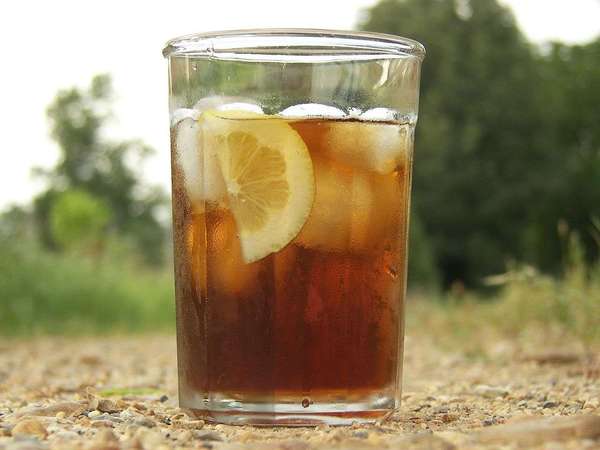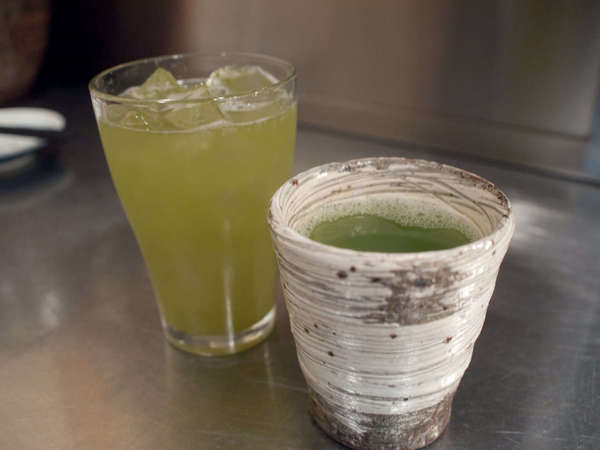Iced Tea
Wikipedia: Iced_teaLast Updated: Apr. 17, 2018
 Photo by MzScarlett / A.K.A. Michelle (Flickr), Photo © MzScarlett / A.K.A. Michelle (Flickr), CC BY 2.0.
Photo by MzScarlett / A.K.A. Michelle (Flickr), Photo © MzScarlett / A.K.A. Michelle (Flickr), CC BY 2.0.Brewing Iced Tea
Brewing iced tea is easy and can be done any number of ways. The most common way of preparing iced tea is to steep tea bags or loose-leaf tea normally, like you would to make hot tea, and then chill it through some combination of adding ice and refridgeration.How much leaf or how many tea bags to use?
If using loose-leaf tea, use the same amount per cup that you would normally use: about 2-3 grams per 8oz cup of water. Use the amount of leaf appropriate to the quantity of tea you want to brew in the end, not the amount of water pouring over the tea, which will be less if you intend to add cold water and/or ice. If using tea bags, consider how many cups the tea bags normally brew, and choose the appropriate number of bags.It is often easiest to brew iced tea in large batches, using a large quantity of leaf or multiple tea bags, brewing a very strong tea, and then watering it down to the appropriate strength. This saves the energy and time required to cool the tea down.
Single-serving iced tea
You can quickly brew a single cup of iced tea by brewing a partly-full cup of tea with the amount of tea and steeping time for a normal-strength cup, and then pouring it over ice, and filling the rest of the way with cold water if necessary.What types of tea to use for iced tea?
 Green tea often makes excellent iced tea. Pictured here is a Japanese green tea. Photo © Matt Lucht (Flickr), CC BY 2.0.
Green tea often makes excellent iced tea. Pictured here is a Japanese green tea. Photo © Matt Lucht (Flickr), CC BY 2.0.Cold brewing
Iced tea can also be cold brewed; cold brewing involves steeping the tea leaves or teabags in cold water, usually for a much longer period of time than regular "hot" brewing. Cold brewing works better for some teas than others and is not a viable option for every tea. Some companies market teabags specifically designed for cold brewing. The amount of time required for cold brewing is hugely variable and ranges from minutes to leaving the tea leaves or bags in the tea indefinitely. In general, cold brewing of tea takes much longer than steeping the tea in hot water.Sweetening iced tea
If you are unsure how sweet your guests are going to want your tea, it is best to avoid adding sweetener to tea until you are ready to drink it. Sugar and other sweeteners cannot be removed, so if you add too much, or if someone wishes to drink unsweetened iced tea, you're stuck. More can always be added to taste at the time of drinking.However, sugar, especially granulated sugar, dissolves slowly in cold water. Liquid sweeteners like honey or agave nectar are better for sweetening iced tea because the sugar is already dissolved; if all you have is granulated sugar, you can dissolve it in water ahead of time to make simple syrup, and then people can add the syrup to sweeten their tea to taste. Another common solution is to brew up two batches, one sweetened, and one unsweetened.
Minimizing energy usage (Promoting Sustainability)
Both heating water and refridgeration to cool water uses energy. If you drink iced tea, you can reduce your energy use in a number of ways:- Brew your own iced tea, using loose tea. Avoid bottled teas, which use more energy and resources in their production and shipping.
- Brew a large quantity of leaf to make a concentrated hot tea, which you then dilute into a larger quantity of water -- this reduces the amount of energy required to heat the water.
- Allow a container of hot or warm brewed iced tea to cool to room temperature before adding ice or placing it in a refridgerator - this reduces the amount of energy required to cool the tea.
- Experiment with cold brewing tea - this uses no energy to heat the water. Keep in mind, however, that some teabag teas marketed as "cold brew" teas may have used more energy and resources in their production than loose-leaf tea that is not specifically intended for cold brewing.
- If you use air conditioning, consider turning your thermostat up a few degrees, and drinking more iced tea to stay cool.

